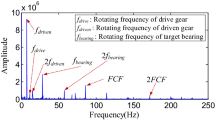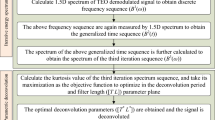Abstract
Time domain averaging(TDA) is essentially a comb filter, it cannot extract the specified harmonics which may be caused by some faults, such as gear eccentric. Meanwhile, TDA always suffers from period cutting error(PCE) to different extent. Several improved TDA methods have been proposed, however they cannot completely eliminate the waveform reconstruction error caused by PCE. In order to overcome the shortcomings of conventional methods, a flexible time domain averaging(FTDA) technique is established, which adapts to the analyzed signal through adjusting each harmonic of the comb filter. In this technique, the explicit form of FTDA is first constructed by frequency domain sampling. Subsequently, chirp Z-transform(CZT) is employed in the algorithm of FTDA, which can improve the calculating efficiency significantly. Since the signal is reconstructed in the continuous time domain, there is no PCE in the FTDA. To validate the effectiveness of FTDA in the signal de-noising, interpolation and harmonic reconstruction, a simulated multi-components periodic signal that corrupted by noise is processed by FTDA. The simulation results show that the FTDA is capable of recovering the periodic components from the background noise effectively. Moreover, it can improve the signal-to-noise ratio by 7.9 dB compared with conventional ones. Experiments are also carried out on gearbox test rigs with chipped tooth and eccentricity gear, respectively. It is shown that the FTDA can identify the direction and severity of the eccentricity gear, and further enhances the amplitudes of impulses by 35%. The proposed technique not only solves the problem of PCE, but also provides a useful tool for the fault symptom extraction of rotating machinery.
Similar content being viewed by others
References
MOHANTY A R, KAR C. Fault detection in a multistage gearbox by demodulation of motor current waveform[J]. IEEE Transactions on Industrial Electronics, 2006, 53(4): 1 285–1 297.
JARDINE A K S, LIN Daming, BANJEVIC D. A review on machinery diagnostics and prognostics implementing conditionbased maintenance[J]. Mechanical Systems and Signal P rocessing, 2006, 20(7): 1 483–1 510.
RANDALL R B, ANTONI J. Rolling element bearing diagnostics-A tutorial[J]. Mechanical Systems and Signal Processing, 2011, 25(2): 485–520.
ZHANG Xiaofei, HU Niaoqing, CHENG Zhe, et al. Enhanced detection of rolling element bearing fault based on stochastic resonance[J]. Chinese Journal of Mechanical Engineering, 2012, 25(6): 1 287–1 297.
FENG Zhipeng, ZUO Mingjian. Vibration signal models for fault diagnosis of planetary gearboxes[J]. Journal of Sound and Vibration, 2012, 331(22): 4 919–4 939.
CHENG Zhe, HU Niaoqing. Quantitative damage detection for planetary gear sets based on physical models[J]. Chinese Journal of Mechanical Engineering, 2012, 25(1): 190–196.
BRAUN S. The extraction of periodic waveforms by time domain averaging[J]. Acustica, 1975, 32(2): 69–77.
MCFADDEN P D. A revised model for the extraction of periodic waveforms by time domain averaging[J]. Mechanical Systems and Signal Processing, 1987, 1(1): 83–95.
MCFADDEN P D, TOOZHY M M. Application of synchronous averaging to vibration monitoring of rolling element bearings[J]. Mechanical Systems and Signal Processing, 2000, 14(6): 891–906.
HALIM E B, CHOUDHURY M A A S, SHAH S L, et al. Time domain averaging across all scales: A novel method for detection of gearbox faults[J]. Mechanical Systems and Signal Processing, 2008, 22(2): 261–278.
ZHU Limin, HE Enhua, DING Han. Comb filter array and its application[J]. Journal of Mechanical Engineering, 2006, 42(5): 1–5. (in Chinese)
MCFADDEN P D. A technique for calculating the time domain averages of the vibration of the individual planet gears and the sun gear in an epicyclic gearbox[J]. Journal of Sound and Vibration, 1991, 144(1): 163–172.
SHIN K. Realization of the real-time time domain averaging method using the Kalman filter[J]. International Journal of Precision Engineering and Manufacturing, 2011, 12(3): 413–418.
YANG Ming, MAKIS V. ARX model-based gearbox fault detection and localization under varying load conditions[J]. Journal of Sound and Vibration, 2010, 329(24): 5 209–5 221.
LIU Hongxing, ZUO Hongfu, JIANG Chengyu, et al. An improved algorithm for direct time-domain averaging[J]. Mechanical Systems and Signal Processing, 2000, 14(2): 279–285.
MCFADDEN P D. Interpolation techniques for time domain averaging of gear vibration[J]. Mechanical Systems and Signal Processing, 1989, 3(1): 87–97.
WU Wentao, LIN Jing, HAN Shaobo, et al. Time domain averaging based on fractional delay filter[J]. Mechanical Systems and Signal Processing, 2009, 23(5): 1 447–1 457.
BRAUN S. The synchronous(time domain) average revisited[J]. Mechanical Systems and Signal Processing, 2011, 25(4): 1 087–1 102.
EBRAHIMI E. Fault diagnosis of spur gear using vibration analysis[J]. Journal of American Science, 2012, 8(1): 133–138.
SAMUEL P D, PINES D J. A review of vibration-based techniques for helicopter transmission diagnostics[J]. Journal of Sound and Vibration, 2005, 282(1): 475–508.
WANG Xiyang, Makis V, YANG Ming. A wavelet approach to fault diagnosis of a gearbox under varying load conditions[J]. Journal of Sound and Vibration, 2010, 329(9): 1 570–1 585.
OPPENHEIM A V, SCHAFER R W, BUCK J R. Discrete-time signal processing[M]. New Jersey: Prentice Hall, 1999.
RABINER L, SCHAFER R, RADER C. The chirp z-transform algorithm[J]. IEEE Transactions on Audio and Electroacoustics, 1969, 17(2): 86–92.
WANG T T. The segmented chirp Z-transform and its application in spectrum analysis[J]. IEEE Transactions on Instrumentation and Measurement, 1990, 39(2): 318–323.
SARKAR I, FAM A T. The interlaced chirp Z transform[J]. Signal Processing, 2006, 86(9): 2 221–2 232.
Author information
Authors and Affiliations
Corresponding author
Additional information
This project is supported by National Natural Science Foundation of China(Grant Nos. 51125022, 51005173), PhD Programs Foundation of Ministry of Education of China(Grant No. 20110201110025), and the Fundamental Research Funds for the Central Universities of China
ZHAO Ming is currently a doctoral candidate at School of Mechanical Engineering, Xi’an Jiaotong University, China. He received his BS and MS degrees from Xi’an Jiaotong University, China, in 2006 and 2009, respectively. His research interests include non-stationary signal processing, rotor dynamics and fault diagnosis of rotating machinery.
LIN Jing is a professor at State Key Laboratory for Manufacturing System Engineering, Xi’an Jiaotong University, China He obtained his BSc, MSc and PhD degrees respectively in 1993, 1996 and 1999, all in mechanical engineering. He was working as a postdoctoral fellow and research associate from July 2001 to August 2003, respectively in University of Alberta, Canada, and University of Wisconsin-Milwaukee, USA. From September 2003 to December 2008, he was working as a research scientist at Institute of Acoustics, Chinese Academy of Sciences, under the sponsorship of the Hundred Talents Program. He also obtained the National Science Fund for Distinguished Young Scholars in 2011. Now his research directions are non-stationary signal processing, wavelet analysis, fault diagnosis and mechanical system reliability.
LEI Yaguo received his bachelor degree in 2002 and PhD degree in 2007 both in mechanical engineering from Xi’an Jiaotong University, China, and worked as a postdoctoral fellow at Department of Mechanical Engineering, University of Alberta, Canada. He is currently an associate professor in mechanical engineering of Xi’an Jiaotong University, China. His research interests include advanced signal processing techniques, hybrid intelligent prognostics and machinery health condition monitoring and fault diagnosis.
WANG Xiufeng received his BS and PhD degrees from Xi’an Jiaotong University in 2003 and 2009, respectively. He is currently a lecturer in mechanical engineering of Xi’an Jiaotong University, China. His research interests include rotor dynamics and vibration control.
Rights and permissions
About this article
Cite this article
Zhao, M., Lin, J., Lei, Y. et al. Flexible time domain averaging technique. Chin. J. Mech. Eng. 26, 1022–1030 (2013). https://doi.org/10.3901/CJME.2013.05.1022
Received:
Revised:
Accepted:
Published:
Issue Date:
DOI: https://doi.org/10.3901/CJME.2013.05.1022




